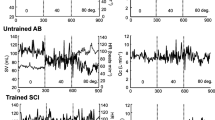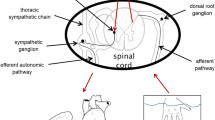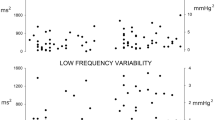Abstract
Objective
To examine blood pressure responses during passive walking-like exercise in the standing posture (PWE) in spinal cord-injured (SCI) humans.
Methods
Twelve motor-complete SCI individuals (cervical level 6 to thoracic level 12, ASIA grade: A or B) and twelve able-bodied controls (CON) participated in this study. SCI individuals were divided into a group with injury level at or above thoracic (T) 6 (HSCI, n = 7) and a group with injury level at or below T10 (LSCI, n = 5). Subjects carried out 6-minute quiet standing and then 12-minute PWE at 1 Hz using a gait training apparatus that enables subjects to stand and move their legs passively.
Results
Mean arterial blood pressures (MAPs) at standing in HSCI, LSCI and CON were 69 ± 5, 83 ± 4 and 93 ± 2 mmHg, respectively. MAP changed significantly during PWE only in HSCI and CON, increasing to 88 ± 4 (P < 0.001) and 98 ± 1 mmHg (P < 0.01), respectively. The former group showed a larger increase in MAP (P < 0.001).
Interpretation
Spinal sympathetic reflexes can be induced in a region isolated from the brainstem in response to a stimulus originating below the level of the spinal cord injury, and the magnitude of increase in blood pressure is greater in SCI individuals with lesion level at or above T6 due to loss of supraspinal control of the major sympathetic outflow. This central mechanism may be one of the reasons why greater pressor response to PWE was observed in HSCI.




Similar content being viewed by others
References
Ackery AD, Norenberg MD, Krassioukov A (2007) Calcitonin gene-related peptide immunoreactivity in chronic human spinal cord injury. Spinal Cord 45:678–686
Adams MM, Ditor DS, Tarnopolsky MA, Phillips SM, McCartney N, Hicks AL (2006) The effect of body weight-supported treadmill training on muscle morphology in an individual with chronic, motor-complete spinal cord injury: a case study. J Spinal Cord Med 29:167–171
Bajd T, Munih M, Kralj A (1999) Problems associated with FES-standing in paraplegia. Technol Health Care 7:301–308
Ballaz L, Fusco N, Cretual A, Langella B, Brissot R (2007) Acute peripheral blood flow response induced by passive leg cycle exercise in people with spinal cord injury. Arch Phys Med Rehabil 88:471–476
Burton AR, Brown R, Macefield VG (2008) Selective activation of muscle and skin nociceptors does not trigger exaggerated sympathetic responses in spinal-injured subjects. Spinal Cord (in press)
Claydon VE, Krassioukov AV (2006) Orthostatic hypotension and autonomic pathways after spinal cord injury. J Neurotrauma 23:1713–1725
Claydon VE, Steeves JD, Krassioukov A (2006) Orthostatic hypotension following spinal cord injury: understanding clinical pathophysiology. Spinal Cord 44:341–351
Consortium for Spinal Cord Medicine (2001) Acute management of autonomic dysreflexia: individuals with spinal cord injury presenting to health care facilities, 2nd edn. Paralyzed Veterans of America, Washington, DC
Corbett JL, Frankel HL, Harris PJ (1971) Cardiovascular changes associated with skeletal muscle spasm in tetraplegic man. J Physiol (Lond) 215:381–393
Dela F, Mohr T, Jensen CM, Haahr HL, Secher NH, Biering-Sorensen F, Kjaer M (2003) Cardiovascular control during exercise: insights from spinal cord-injured humans. Circulation 107:2127–2133
Dietz V, Muller R (2004) Degradation of neuronal function following a spinal cord injury: mechanisms and countermeasures. Brain 127:2221–2231
Ditor DS, Macdonald MJ, Kamath MV, Bugaresti J, Adams M, McCartney N, Hicks AL (2005) The effects of body-weight supported treadmill training on cardiovascular regulation in individuals with motor-complete SCI. Spinal Cord 43:664–673
Faghri PD, Yount JP, Pesce WJ, Seetharama S, Votto JJ (2001) Circulatory hypokinesis and functional electric stimulation during standing in persons with spinal cord injury. Arch Phys Med Rehabil 82:1587–1595
Garrison MK, Ng AV, Schmit BD (2008) Leg sympathetic response to noxious skin stimuli is similar in high and low level human spinal cord injury. Clin Neurophysiol 119:466–474
Giangregorio L, Blimkie CJ (2002) Skeletal adaptations to alterations in weight-bearing activity: a comparison of models of disuse osteoporosis. Sports Med 32:459–476
Hopman MT, Nommensen E, van Asten WN, Oeseburg B, Binkhorst RA (1994) Properties of the venous vascular system in the lower extremities of individuals with paraplegia. Paraplegia 32:810–816
Kawashima N, Nakazawa K, Akai M (2005) Muscle oxygenation of the paralyzed lower limb in spinal cord-injured persons. Med Sci Sports Exerc 37:915–921
Krassioukov AV, Harkema SJ (2006) Effect of harness application and postural changes on cardiovascular parameters of individuals with spinal cord injury. Spinal Cord 44:780–786
Krum H, Louis WJ, Brown DJ, Howes LG (1992) Pressor dose responses and baroreflex sensitivity in quadriplegic spinal cord injury patients. J Hypertens 10:245–250
Marsh DR, Weaver LC (2004) Autonomic dysreflexia, induced by noxious or innocuous stimulation, does not depend on changes in dorsal horn substance p. J Neurotrauma 21:817–828
Mathias CJ, Frankel HL (1992) The cardiovascular system in tetraplegia and paraplegia. In: Frankel HL (ed) Spinal cord trauma, handbook of clinical neurology. Elsevier, Amsterdam, pp 435–456
McLachlan EM, Brock JA (2006) Adaptations of peripheral vasoconstrictor pathways after spinal cord injury. Prog Brain Res 152:289–297
Mizushima T, Tajima F, Okawa H, Umezu Y, Furusawa K, Ogata H (2003) Cardiovascular and endocrine responses during the cold pressor test in subjects with cervical spinal cord injuries. Arch Phys Med Rehabil 84:112–118
Muraki S, Yamasaki M, Ehara Y, Kikuchi K, Seki K (1996) Cardiovascular and respiratory responses to passive leg cycle exercise in people with spinal cord injuries. Eur J Appl Physiol 74:23–28
Nash MS, Bilsker MS, Kearney HM, Ramirez JN, Applegate B, Green BA (1995) Effects of electrically-stimulated exercise and passive motion on echocardiographically-derived wall motion and cardiodynamic function in tetraplegic persons. Paraplegia 33:80–89
Nash MS, Jacobs PL, Johnson BM, Field-Fote’ E (2004) Metabolic and cardiac responses to robotic-assisted walking in motor-complete tetraplegia: a case report. J Spinal Cord Med 27:78–82
Nobrega AC, Williamson JW, Friedman DB, Araujo CG, Mitchell JH (1994) Cardiovascular responses to active and passive cycling movements. Med Sci Sports Exerc 26:709–714
Nurhayati Y, Boutcher SH (1998) Cardiovascular response to passive cycle exercise. Med Sci Sports Exerc 30:234–238
Rowell LB (1993) Human cardiovascular control. Oxford University Press, New York
Ter Woerds W, De Groot PC, van Kuppevelt DH, Hopman MT (2006) Passive leg movements and passive cycling do not alter arterial leg blood flow in subjects with spinal cord injury. Phys Ther 86:636–645
The Consensus Committee of the American Autonomic Society, the American Academy of Neurology (1996) Consensus statement on the definition of orthostatic hypotension, pure autonomic failure, and multiple system atrophy. Neurology 46:1470
Weaver LC, Marsh DR, Gris D, Brown A, Dekaban GA (2006) Autonomic dysreflexia after spinal cord injury: central mechanisms and strategies for prevention. Prog Brain Res 152:245–263
Yang HJ, Gil YC, Lee WJ, Kim TJ, Lee HY (2008) Anatomy of thoracic splanchnic nerves for surgical resection. Clin Anat 21:171–177
Acknowledgment
This study was supported by the Ministry of Health, Labor and Welfare of Japan.
Author information
Authors and Affiliations
Corresponding author
Rights and permissions
About this article
Cite this article
Ogata, H., Higuchi, Y., Ogata, T. et al. Pressor response to passive walking-like exercise in spinal cord-injured humans. Clin Auton Res 19, 113–122 (2009). https://doi.org/10.1007/s10286-008-0504-x
Received:
Accepted:
Published:
Issue Date:
DOI: https://doi.org/10.1007/s10286-008-0504-x




